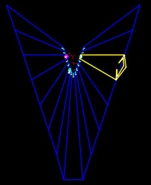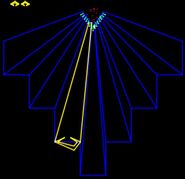(rest of fixes, formatting, some re-writing) |
|||
| Line 115: | Line 115: | ||
{{Reflist}} |
{{Reflist}} |
||
| + | |||
| + | [[Category:Miscellaneous Vectrex]] |
||
| + | [[Category:Vectrex games]] |
||
Revision as of 05:24, 4 December 2013
Background
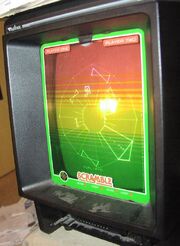
A Vectrex running the unfinished Tempest clone Abyss from Vecmania.
Atari was founded in 1972 after being built on the success of Pong, the second wide-released arcade game ever. They would later produce thousands of video games for the handheld, home video game console, arcade and computer markets, along with producing many of their own home video game consoles and other hardware. The company would later be proclaimed as to being a more recognizable brand than Coca-Cola.
Unfortunately by the 1990s, Atari's fortunes would become reversed, as the company ceased, with its brand name being sold off to Midway, Hasbro, and Infogrammes, the latter of which changed their name to Atari in the early 2000s. In November, 2013, Atari would seek bankruptcy protection.
The Vectrex was released in 1982, five years after one of the biggest best-selling video game consoles of all time, the Atari 2600, debuted. Many Vectrex games were clones of games either originally made by Atari or ones found on the Atari 2600 made by other companies, mostly as modern day homebrews.
GCE original clones
Mine Storm was the built-in game for the Vectrex, being a clone of the arcade game Asteroids. It had many differences though, as a Minelayer would appear at the beginning of every Mine Field and lay a batch of mines in its wake (in the form of dots). These dots would then hatch into large mines, which, once the player(s) shot one, two additional ones would hatch from two dots somewhere on the screen, and shooting one of the medium-sized mines would hatch into two small mines from somewhere on the playfield. (On Asteroids, all asteroids were shown right from the start and split into smaller ones whenever the larger ones were destroyed, not hatching from other locations.)
Once the last small mines had hatched, the Minelayer would come out again (like the U. F. O. on Asteroids) and would start leaving behind more mines unless the player destroyed it, only appearing once, whereas the U. F. O.s on Asteroids appeared repeatedly during a level.
Unlike with straight asteroids, there were many different types of mines, such as Magnetic ones (that would follow the player’s ship around), Fireball mines (which shot a fireball usually right at the player) and Magnetic-Fireball mines (combining the two abilities). Alien forces, space dust and a fireball also appeared in some versions of the game (as several versions were released). The game also featured an Escape function (like Asteroid's Hyperspace), which never destroyed the player’s ship, unlike how it could on Asteroids (which had a one in five chance of happening).
Other notable games
Bedlam and Web Wars have been compared to the arcade game Tempest, although the games only have a few elements each in common with Tempest, rather than being exact clones.
Bedlam indeed has a Zap feature (similar to the Super Zapper on Tempest) that destroys every onscreen enemy (except for an occasional bug where they still remain even after the function was used) and enemies come out of the ends of geometric shapes to swarm the player. However, the game is a “reverse” of Tempest, as the player’s ship is in the middle of levels, rather than on the outer lanes. Later levels also start rotating, which was not in the original, plus Tempest has many more levels than Bedlam does.
Web Wars can look like levels eight and nine of Tempest as well (see gallery below), but that is pretty much where all comparisons end, as the web is constantly moving and changing shape, which Tempest lacked, as none of its levels moved. There are also far fewer onscreen enemies than with Tempest, no Super Zapper, the player is free to move around a much larger area than just the outskirts of levels in Tempest, plus it is the player’s duty to catch various creatures and deposit them in a Trophy Room, which, if they do not do this quickly enough during a level, a Cosmic Dragon will appear and start firing down on the player, none of these elements were found in Tempest.
Modern day homebrew clones
After being discontinued in 1984, a resurgence for the Vectrex began in 1995 with the release of the very first version of the Sean Kelly Multicart, containing ROMs of the original GCE games. However, this movement really started taking place in 1996 when programmer John Dondzila created several homebrew games, which dozens more have followed over the years.
One of Dondzila’s earliest works included Vectrepede, which is the unlockable game found on Spike Hoppin'. This is a stripped-down version of the arcade game Centipede, however, as no scorpions or fleas appear. There are also fewer mushrooms, and every one can be shot away, and without a flea re-seeding the player’s area like on Centipede, these will only be replenished when another Vectrepede segment is shot. The game is for only one player (unlike with up to two alternating turns on Centipede) and they would receive no bonus for any partially shot mushroom after a wave, plus the spider is also worth only one set point value (300 points, no matter the distance from the player’s gun when shot, as on Centipede it could be worth 600 or 900). However, the player’s gun will spin around when it gets hit by a Vectrepede or spider, which was not on the original.
Another early cartridge from Dondzila was Patriots, a Missile Command clone from the arcade. This version included only two missile bases that could fire, however, rather than three, and enemy satellites, planes and smart bombs appeared much earlier than on the arcade original. A Limited Edition of the game was also released that only had 150 copies made, and Breakout was included as a hidden bonus game on both (a clone of the arcade game of the same name), which the player controlled a paddle that must clear screens of bricks by rebounding a ball against a wall. The speed of the paddle movement could be changed, and from the second screen and on, each brick took two hits before it could be removed from the screen, unlike on the original Breakout (with either feature).
Dondzila also created two individually-released Rockaroids games (the limited edition and Remix, along with a third version included in the later Vecmania cartridge). The limited edition Rockaroids cartridge only had 150 copies made, which is a clone of Asteroids, although with several minor differences.

Rockaroids
The player’s ship does not thrust in the same manner as on the arcade version. The large rockaroids are proportionally bigger than the largest asteroids on the original game, plus the point values for most targets were cut in half (being worth 10, 20 and 50 points each from the largest to smallest rockaroids verses 20, 50 and 100 points for the largest to smallest asteroids in the original). The game’s difficulty level is also not as high as the original arcade game, as it is not uncommon for rockaroids to travel in a straight line moving either vertically on the sides of the screen or horizontally near the very bottom or top, plus there is a bit more slowdown at times with many rockaroids onscreen, rather than with Asteroids.
The saucers also do not come out during the same intervals, as at times one will come out only seconds after a previous one was destroyed, plus they do not destroy a rockaroid (or break up a larger one) when they collide with one unlike with Asteroids. Also, the large saucer still will come out well after 10,000 points are scored during a game, the small saucer can come out with as little of 3,000 points scored (unlike how they did not appear until well after 10,000 points were scored on the original), plus the saucers get mixed: even after the player has earned tens of thousands of points during a game of Rockaroids, the large saucers will still come out at times, rather than it just being the small saucers on the original after 10,000.
The player’s ship is also invincible for several seconds at the beginning of every new level and with every reserve ship that comes into play (unlike with Asteroids) and the game is for one player only (rather than up to two players alternating turns), although when the player earns an extra ship, the font for ships remaining grows a lot larger and becomes very bright for a few seconds, which did not happen with the original game.
Rockaroids Remix, on the other hand, gives the player’s ship the look of the ship on the Asteroids Deluxe arcade game, plus the rockaroids travel at a much faster rate of speed than with Rockaroids and especially the original Asteroids.
Dondzila also made several compilation cartridges, starting with All Good Things in 1996, which contained five games, three of which were clones of Atari games or those found on the Atari 2600.
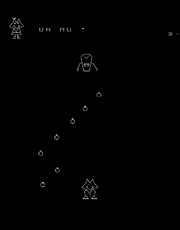
Spike's Water Balloons
Rockaroids was included, which is the same as the limited edition game. Spike’s Water Balloons, however, is a clone of the Atari 2600 game Kaboom!, although the player’s buckets were replaced with Spike, and the bombs with water balloons. Spike had to pop them with his head, which is a bit thinner than the original buckets, plus one chance is all the player gets to pop the balloons, as there are no second or third chances (buckets) like on the original. However, there is the additional feature of being able to kick a balloon back up to the top of the screen if one is missed, along with the ability to tweak Spike’s moving speed (unlike the default, unchangeable bucket speed on the original game). The game also does not get as frantic as the original, plus only the water balloon that hits the ground will pop, unlike all of the bombs exploding on the original, plus there is a longer pause in between rounds, unlike with the original, which there is almost no pause at all.
Vectris (aka Vectrex Blocks) is a clone of the arcade game Tetris, where shapes come down from the top of the screen and they must be placed together in a certain order in order to form straight horizontal lines; with the more lines that are completed, the longer the game will continue. However, rather than having certain obstacles appear in the later levels to try to impede the player from forming lines, there being actual levels and bonuses awarded during a game, this is a common stripped-down version where it is just one continuing game that just gets faster as it goes along without a break until the pieces eventually stack to the top and ends the game. The pieces also drop down faster than on the original game as well.
Dondzila’s next multicart a few years later was Vecmania, containing nine games total, several of which were Atari clones.
One game was Abyss, which is an unfinished clone of the first level of Tempest. Dondzila didn’t properly plan out the level design ahead of time and didn’t like the way the game was looking, so he did not complete it[1]. The only elements present are Flipper-like enemies from the original game (which jump around due to not being finished and polished, plus they do not “flip” towards the player’s blaster once they reach the edge of a level [as they will just disappear]), Spikers, Spikes, and shots that are fired from enemies. The player can only shoot enemies, shots and Spikes, as there is no way to die, along with the game also having no sound or scoring.
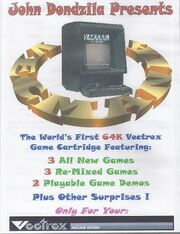
Vecmania
Once more, Patriots Remix is a clone of Missile Command, which again (like with the original Patriots) only has two missile bases that fire (which move in conjunction with the cursor), with no middle area/base whatsoever. Bombers and satellites appear during the very first wave, unlike with the original game, and smart bombs follow quickly afterwards, although they dodge fire by moving upwards like on Missile Command for the Atari 2600, rather than quickly moving to the sides while still moving downwards without pause on the arcade original. The game is also for one player only (unlike two alternating turns on Missile Command), although the speed of the cursor can be tweaked, and there is a graphics bug where if an enemy missile is destroyed too close to a screen edge, the explosion will appear on the opposite side (i. e. if a missile is destroyed on the far right edge, part of its explosion will appear at the same height on the left side of the screen as well), which never happened with any of the Atari versions of the game. The player’s missiles also move at about the same fast rate as on the Atari 2600 version of the game (i. e. faster than on the arcade version).
Breakout is again included and is unlocked in the same manner as on the earlier Patriots cartridge. This is the exact same game as the original Breakout on that cartridge as well, although some lines were removed from the blocks, allowing the game to run faster (as too many onscreen vectors can slow down the Vectrex).
A third version of Rockaroids was also included entitled Rockaroids Remix: Third Rock. Like with the previous Rockaroids games, the player’s ship is invincible for several seconds for each reserve ship and with each new level. However, large rockaroids can move fast, which not only did they never do this on Asteroids, but they also travel fast on the very first screen on this version. The small saucer can also appear on the very first screen as well, rather than not appearing until after 10,000 points were scored on the original Asteroids. Saucers can also pass right through rockaroids without harm this time around, and rockaroids rotate like in Asteroids Deluxe, which the player’s ship also is shaped like the ship on that game as well. However, there is a bug where sometimes rockaroids will suddenly appear right below the player’s ship from out of nowhere, which did not happen with any of the official Asteroids games, along with the saucers, when they shot a rockaroid, would not add to the player's score like it does on this version.
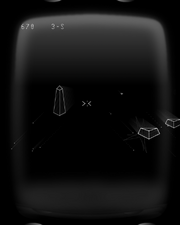
Star Fire Spirits (second wave)
Another included game is Star Fire Spirits, being a clone of the Atari vector arcade game Star Wars. During the first wave, the T. I. E. Fighter-like ships only come straight forward, not curving about as the camera angle changes from fighter to fighter unlike on the original game, plus their shots are more star-, rather than fireball-shaped, making them harder to see. This wave also takes longer to finish than with the original, as the player has to shoot a certain number of ships before advancing to the next wave (as the player has to wait for them to appear one by one and/or move their ship around while trying to find them), although this speeds up with the player destroying Dark Planet (rather than being called the Death Star) at least once and the cycles start repeating.
There is only one starting level to the game (unlike three skill levels to choose from at the start of a game with the original), as with the second stage on Dark Planet, the bunkers and laser towers are present already (which on the beginning level of the arcade original, the bunkers and laser towers do not start appearing until later in the game), although the latter appear in random fashion, unlike how they were in set places with the original game. A bonus is still awarded if all laser tower tops are destroyed, however. The final stage is also just set one way, as no catwalks appear in the later levels like with the arcade original, plus the player’s Photon Torpedoes automatically fire at the end, which this action is not shown on this version, although the player can still use “the Source” (rather than the Force) in order to destroy Dark Planet (i. e. not firing during the entire run until they get to the exhaust port).
There is also a bug that makes the player’s crosshairs jump from one side of the screen to the other, which was not on the original game, the player won’t earn a shield unit back with each time Dark Planet is destroyed (even though the instructions claim this), although they are able to change the speed of their crosshairs movement, an extra control was added (a reverse feature during the first wave only) and the player can choose between either regular or flight (flipped) controls.
Vectopia was the next compilation cartridge from Dondzila, having several full games and many unfinished or early demos of games that would be completed later, several of which were also Atari or related clones.
Spike's Water Balloons Analog is the exact same game as Spike’s Water Balloons on All Good Things, although it was made to work with the Vectrex’s analog controller (as homebrewers have made conversions of digital controllers for the Vectrex). There is no function this time around in order to speed up Spike though. The Star Fire Early Work demo was also included, being the second round that would become the Star Fire Spirits game off Vecmania, giving the game a slightly different look and the player can rotate the screen around (which would later be left out of the finished game) by pressing buttons three and four on their controller (although just moving the target site will also cause the screen to roll a bit too), although with no collision detection, the player cannot blow off the tops of the laser towers, which do not fire at the player, and the bunkers are missing, along with sound.
The Star Fire Early Work II demo is actually a clone of the first stage of the Star Wars arcade game. Here the T. I. E. Fighter-like ships look and act more like the ships on the original game, as they tumble around and their shots are larger, being closer to the ones on the arcade original (unlike how this would be changed on the released version of Star Fire Spirits). There is no scoring and sound and no way to advance any further on the demo though, which will end after the player has received six hits on their shields.
Dondzila’s final compilation cartridge, Gravitrex Plus, contained three games, two of which were Atari clones, one being Gravitrex, which is a clone of the Gravitar arcade game, where the player must infiltrate a number of planets while destroying bunkers and beaming up fuel cells. Their ships are also constantly using up fuel and players must contend with gravity as well.
However, on Gravitrex, it is mandatory (unlike with Gravitar) to beam up every single fuel cell, destroy every single bunker and rescue all humans on every planet (which the latter were not present in the original) in order to destroy a planet; in Gravitar, the only requirement was to destroy all planetary bunkers. Planets also have different landscapes and the reactor planet is now mandatory to destroy in order to advance to the next level (which originally this was just a bonus planet, which would destroy the entire solar system, plus bunkers would not pop up once the reactor was shot like on the original). Gravitrex only has three levels and then the game will end after level three is complete, unlike with Gravitar, which has many more levels and invisible landscapes and such. Gravitrex is also for one player only (which the original had up to two players alternating turns), but also has an Arcade setting that is exactly the same as the Standard game except that the player’s ship is more sensitive to the turning controls.
Patriots III BALListic Busters was also included on the cartridge, which is once more a clone of Missile Command, although the player is allowed (mostly) unlimited firepower, only receiving slight pauses at times when their bases need to reload after firing several shots, unlike with the arcade original (so the player will not earn a bonus for any remaining missiles at the end of a wave on this version). Saucers and bombers also appear right off the bat to drop missiles as they fly by, and the fire-eluding Smart Bombs appear after only the third wave, unlike how they do not appear on Missile Command until later in the game.
The game is also only for one player (unlike up to two alternating turns on the original), but the cursor speed can be changed on the fly, along with if the player wants to choose between using the original Vectrex analog or modern day digital control.
Many other homebrewers besides Dondzila made games for the Vectrex as well, also being Atari clones. Some are just demos, such as Bcor-FTS by Clay Cowgill, who’s aim was to “annoy Dondzila”[2] with more realistic inertia with the player’s ship than on Rockaroids (as this demo is also a clone of Asteroids). Although the player still shoots rocks, they move very quickly, but they pass right through the player’s ship. The only score is a tally of how many rocks are destroyed, although that resets with every cleared level. There are also no saucers or sound in the game.
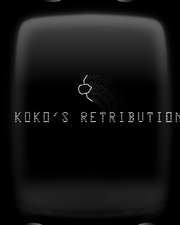
Koko's Retribution title screen.
Koko's Retribution is a clone of Yars' Revenge from the Atari 2600. Koko (rather than the Yar that the player controls) won’t instantly change directions when instructed by the player, but rather rotates around, along with not wrapping around screen edges like with the original game. There is only one game this time around, unlike with seven variations on the original. The difficulty increase is also a bit slower (as the enemy missile takes a lot longer before it starts moving quickly). The neutral zone is always there (unlike on the original when it doesn’t appear with every other level), plus the player can still die inside it when being hit by the missile.
The shield also had many features changed, as there are only two layers to be destroyed. It can be shot for points, but it won’t damage the shield, unlike on the original game. The player can only press against the front part of the shield to earn a cannon (as touching the top or bottom parts won’t work) until their cannon appears behind them. There is also only one kind of shield as well (as the moving, dense second kind from the original game was omitted).
The enemy also charges across the screen four times before returning to its original docile state behind the shield, which it only charged the player once on the original game, and the enemy can’t be destroyed while it’s in its swirl state this time around. However, there is a cinematic cutscene when the enemy is destroyed, as Koko flies off to the next level (which also was not in the original), plus a different scoring system is in place as well.
Another homebrew, Moon Lander, is a clone of the Lunar Lander arcade game. The game is more action-oriented than its inspiration though, as the player’s moon lander descends landscapes far faster than with the arcade original. The landscapes also do not zoom in once the player’s ship nears a landing area, so the features of the landing zones are consistently small this time around. There are also one to three landing sites per planet, rather than just three like on the original. The player also receives an onscreen “OK!” indication that their landing trajectory is on track, which was not on the original either, as well as a full screen cutscene showing the lander taking off for the next moon (which each moon’s name is also identified onscreen) after a successful landing, complete with a brief musical score.
There are also 32 moons to land on, which have varying gravity, wind, and even satellites that can chase and destroy the lander, along with an ending to the game if the player is able to beat it. Also, rather than adding fuel via inserting more quarters or tokens than on Lunar Lander, the player instead has five landers and earns an extra with every fourth successful moon landing, along with fuel being added then as well.
Spike Goes Down is a hidden game found on the Protector LE cart, sharing many similarities (as it shares the same programmer of Alex Herbert) with the homebrew of Man Goes Down for the Atari 2600, as the Spike has to drop down a continuously scrolling area without making contact with any of the "pointy bits"[3] at the top and bottom of the screen, which would end the game. However, with Man Goes Down, there were 12 different items to collect, and it had support for the AtariVox homebrew module (which could save high scores), which neither feature is included on Spike Goes Down.
Unlike with how Abyss was never finished, on Tsunami/VIX, Tsunami was a fully completed clone of Tempest. It did not quite match the intensity of Tempest though, although all 16 levels were included, and it came with an adjustable joystick sensitivity setting.

Vaboom!
Also like with Spike’s Water Balloons, Vaboom! is another clone of Kaboom!, where the player moves three onscreen paddles (on this version, rather than buckets) to catch bombs dropped by “the man” (as he is identified here, rather than as the "mad bomber" on the original). The game starts off a lot faster than with the original though, plus occasionally a bomb will fly back upwards towards the man. If the man gets hit by bombs 10 times, then the player will enter a bonus screen where if any bombs are missed it will not count against them (i. e. they won’t lose a paddle). A bonus diamond is also occasionally dropped, which is worth bonus points, and the player can also earn a paddle back by catching on onscreen heart. However, catching an X will cause them to lose a paddle, which none of these features were on the original game. Vaboom! can also be played with a modified Atari 2600 Paddle Controller and has text messages after every completed level (which Kaboom! lacked), although the game is only for one player (rather than two alternating turns) and crashes on level 19, which the man stops dropping bombs then and only drops hearts, diamonds and Xs.
Spike's Spree (off VeCaves/Spike's Spree) was based on Fast Food from the Atari 2600, where the player controlled a mouth (Mighty Mouth) that had to eat various foods as they flew from the left side of the screen. Unlike having the game end by eating six purple pickles by accident, this time around half of what Spike eats (used in place of a Mouth this time around) could kill him (Birds, Bouncers, and Spud from the original Spike), and the other, actual “good food” (Molly, Molly’s bow and her cage) Spike had to eat in a certain order in order to continue throughout the game.
And ZSB is an unlockable game found on Thrust, which is a clone of The Empire Strikes Back for the Atari 2600. Unlike with the original, an actual rebel base is found this time around at the beginning (as no base is seen when a Walker makes it to the area on the original, as the game will just end). Walkers also do not take 48 hits to be destroyed (along with having no bomb hatches), plus they only fire one type of shot (i. e. no smart bombs) this time around. The player also does not receive any pit stops to repair damage to their ship (which also leaves out the Difficulty Level setting to make the areas smaller), along with there being no Force to make them temporarily invincible unlike on the original. Walkers also do not slow down when taking damage, as they can only be destroyed. However, they will start jumping after several have been destroyed, which was not on the original. There is also only one game included as well, not 32 like with the original, and it is for one player only, unlike two alternating turns on Empire.
Other notable game
Thrust is considered to be a clone of Gravitar, due to the player controlling a ship that must penetrate a series of planetary landscapes to destroy bunkers and beam up fuel cells. However, the player’s main goal is to secure a series of pods that hang from their ship once acquired, which, if the player uses too much thrust afterwards, can cause their ship to spin around like a pendulum. Also unlike with Gravitar, planets do not get destroyed unless the player shoots their nuclear reactor 14 times, and the game comes with two additional playing modes as well. Thrust also has only six basic planets (with an additional two on the Hard+ mode) before they start repeating, although at a higher difficulty level (such as reverse gravity and invisible landscapes).
Trivia
- The Vectrex also had a few official ports that can be found on various Atari platforms as well, such as Berzerk (Atari 2600 and 5200 consoles), Star Castle (which was the only official port of the game at the time, then decades later two homebrewed versions were created for the Atari 2600), Space Wars (which a clone of Space War for the Atari 2600 had several game variations that very closely resembled the arcade original) and Pole Position (Atari 2600 and 5200). Clones of games from the original GCE lineup whose officially ported cousins on various Atari platforms include Clean Sweep/Mr. Boston (Pac-Man clone), and modern day homebrewed clones include Becky's Message (a clone of the first level of Donkey Kong), Birds of Prey (Phoenix clone, which a port was made for the Atari 2600), Vectrace’s programmer Ronen Habot was inspired by Street Racer for the Atari 2600 for his overhead-viewed racing game, Y*A* S* I, Vector Vaders, More Invaders! and Vector Vaders Remix are all clones of Space Invaders (ported to most Atari game consoles and computers), Protector (Defender clone, ported to many Atari and non-Atari consoles and computers), V-Frogger (Frogger clone, ported to the Atari 2600 and 5200), the Omega Chase games (Deluxe and the Collector's Edition) are clones of Omega Race (ported to the 2600), Spike Hoppin' is a clone of Q*Bert (ported to the 2600 and 5200), Trakkers and Wormhole off Vectopia are clones of Universal Chaos and Gyruss, respectively for the 2600, Vector Pilot is a clone of Time Pilot (2600), and the Vectrexians games (unlimited edition and Vectrexians Deluxe) are clones of Galaxian (for many Atari game consoles, computers and non-Atari platforms published by AtariSoft).
- The programmer behind the original Thrust had stated that his game was inspired by Gravitar.
References
- ↑ Official Vecmania page.
- ↑ E-mail from Cowgill.
- ↑ Alex Herbert's official site.

